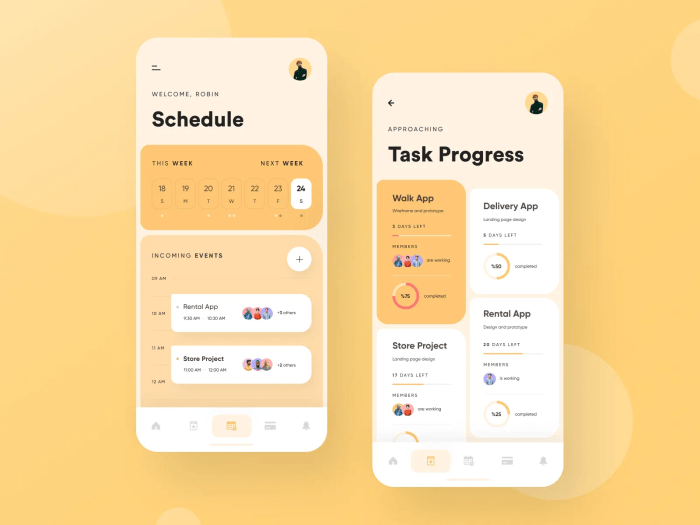Schedule Creator App A Digital Revolution
Schedule creator apps are rapidly transforming how we manage time and tasks, from personal calendars to complex project management tools. This evolution, driven by increasing digital integration, highlights the crucial role these apps play in modern productivity. From basic reminders to sophisticated collaboration features, the range of functionalities available in schedule creator apps is vast and constantly expanding.
This analysis delves into the essential components of effective schedule creator apps, exploring user experience, key features, integration capabilities, and mobile design considerations. It also examines emerging trends and use cases across various sectors, from personal organization to business strategy, to project management.
Schedule Creator Apps: A Comprehensive Overview
Schedule creator apps have become indispensable tools for individuals and teams across various sectors. These applications streamline the process of organizing appointments, tasks, and deadlines, improving productivity and reducing stress associated with time management. This article delves into the functionalities, design considerations, and future trends of schedule creator apps, providing a comprehensive overview for users and developers alike.
Introduction to Schedule Creator Apps
Schedule creator apps offer a wide array of functionalities, encompassing everything from simple personal calendars to complex project management tools. They commonly include features like appointment scheduling, task management, reminders, and the ability to share schedules with others. These apps have evolved significantly from the rudimentary paper calendars of the past, offering a more efficient and versatile method for managing time and resources.
Different types of schedule creator apps cater to diverse needs. Personal schedule apps focus on individual time management, while team and project-based apps facilitate collaboration among groups. These apps are tailored for various purposes, from managing personal appointments to coordinating large-scale projects.
The evolution of schedule creation tools has been remarkable. From paper calendars and planners, we’ve transitioned to digital solutions offering enhanced features, flexibility, and accessibility. These apps provide greater control over scheduling and facilitate collaboration through shared calendars and integrated communication channels.
| App | Features | Pricing | User Interface |
|---|---|---|---|
| Google Calendar | Event scheduling, reminders, calendar sharing, integration with other Google services | Free (with paid premium features) | Intuitive and user-friendly, utilizing a familiar calendar view |
| Outlook Calendar | Event scheduling, reminders, calendar sharing, integration with Microsoft Office suite | Free (with paid premium features) | Modern design with customizable options, offers various views |
| Calendly | Scheduling meetings, automating responses, integration with email | Various pricing tiers based on features and user count | Simple and straightforward, focuses on ease of scheduling |
User Experience and Interface Design
A user-friendly schedule creator app interface is crucial for seamless usability. Key elements include intuitive navigation, clear visual hierarchy, and effective user feedback mechanisms. Visual cues, such as color-coding and different font sizes, help users quickly grasp the information presented. Efficient navigation enables quick access to various features and functionalities, while effective user feedback mechanisms provide clear confirmation of actions, preventing errors.
Examples of intuitive interface designs often feature drag-and-drop functionalities for scheduling appointments, interactive calendar views, and customizable settings. These design choices prioritize user convenience and ensure a positive experience.
Accessibility features are essential for ensuring inclusivity. These features may include adjustable font sizes, alternative text for images, and keyboard navigation options. This enhances the experience for users with disabilities and broadens the app’s reach.
| Element | Description | Importance |
|---|---|---|
| Visual Hierarchy | Organization of elements based on importance, using visual cues like size and color | Guides user attention and improves readability |
| Navigation | Clear and intuitive paths for accessing different sections and features | Facilitates quick and easy navigation throughout the app |
| User Feedback | Clear indications of actions, confirmations, and errors | Reduces user confusion and ensures accurate actions |
Key Features and Functionality

Schedule creator apps typically incorporate essential features for effective time management. These features facilitate organization, collaboration, and efficient task completion.
- Reminders: Enable users to set reminders for appointments, deadlines, and tasks. Reminders can be tailored to various notification methods (e.g., pop-up alerts, email notifications, or push notifications).
- Calendar View: Provides a visual representation of schedules, enabling users to view appointments, tasks, and events at a glance. Different views (e.g., daily, weekly, monthly) cater to diverse needs.
- Sharing Options: Allow users to share their schedules and calendars with others, fostering collaboration and transparency. Sharing options typically involve granting access permissions.
| Feature | Functionality | Example Use Case |
|---|---|---|
| Reminders | Provides alerts for appointments, deadlines, and tasks | Setting a reminder for a doctor’s appointment |
| Calendar View | Visual representation of schedules | Viewing upcoming meetings for the week |
| Sharing Options | Allows sharing of schedules with others | Sharing a project timeline with team members |



